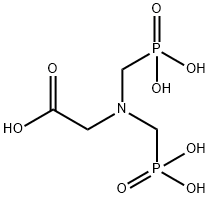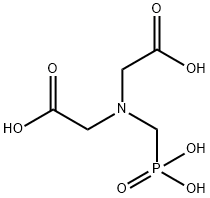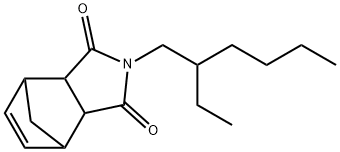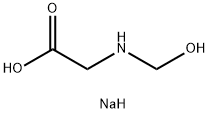Glyphosine
Synonym(s):N-(Carboxymethyl)iminodi(methylphosphinic acid);Glyphosine
- CAS NO.:2439-99-8
- Empirical Formula: C4H11NO8P2
- Molecular Weight: 263.08
- MDL number: MFCD00056670
- EINECS: 219-468-4
- SAFETY DATA SHEET (SDS)
- Update Date: 2024-12-18 14:08:52

What is Glyphosine?
Description
Glyphosine was introduced in 1973 and is preferably used in sugar beets. The synthesis starting with glycine uses two equivalents of formaldehyde and of phosphorous trichloride under oxidative conditions. A second derivative of Glyphosate is a cyclic phosphaoxazole being formed from Glyphosate and formaldehyde. This compound is claimed to control the growth of some grasses without dis- coloration or phytotoxicity.
The Uses of Glyphosine
Application: Complexing agent; pK-values: pK1: ·2, pK2: 2.0, pK3: 5.20, pK4: 6.77, pK5: 10.89
Anti-diabetic; delay onset of diabetes in non-obese NOD mice
Glyphosine binds to a pocket of MHC class II molecules I-Ag7 and DQ8, and modify T cell responses to the autoantigenic insulin B chain fragment 9–23 (B:9–23) peptide. Glyphosine stimulate IL-10 production and delay onset of diabetes in non-obese NOD mice.
The Uses of Glyphosine
Chemical ripener; plant growth regulator.
What are the applications of Application
N,N-Bis(phosphonomethyl)glycine is A complexing agent
Definition
ChEBI: A tertiary amino compound that consists of glycine bearing two N-phosphonomethyl substituents.
General Description
N,N-Bis(phosphonomethyl)glycine was present in the ligand bound to human apotransferrin.
Biochem/physiol Actions
Anti-diabetic; delay onset of diabetes in non-obese NOD mice
Properties of Glyphosine
| Melting point: | 263°C |
| Boiling point: | 668.4±65.0 °C(Predicted) |
| Density | 1.952±0.06 g/cm3(Predicted) |
| storage temp. | +2C to +8C |
| solubility | PBS (pH: 7.2):5.0(Max Conc. mg/mL);19.01(Max Conc. mM) |
| pka | pK1 1.42; pK2 2.10; pK3 5.02; pK4 6.40; pK5 11.19(at 25℃) |
| form | Solid |
| color | White |
| Water Solubility | 248g/L(20 ºC) |
| Merck | 13,4526 |
| BRN | 1884944 |
| CAS DataBase Reference | 2439-99-8(CAS DataBase Reference) |
| EPA Substance Registry System | Glyphosine (2439-99-8) |
Safety information for Glyphosine
| Signal word | Danger |
| Pictogram(s) |
 Corrosion Corrosives GHS05 |
| GHS Hazard Statements |
H318:Serious eye damage/eye irritation |
| Precautionary Statement Codes |
P280:Wear protective gloves/protective clothing/eye protection/face protection. |
Computed Descriptors for Glyphosine
New Products
(S)-3-Aminobutanenitrile hydrochloride 4-Methylphenylacetic acid N-Boc-D-alaninol N-BOC-D/L-ALANINOL Tert-butyl bis(2-chloroethyl)carbamate 3-Morpholino-1-(4-nitrophenyl)-5,6-dihydropyridin- 2(1H)-one Furan-2,5-Dicarboxylic Acid Tropic acid 1-Bromo-3,5-Di-Tert-Butylbenzene S-2-CHLORO PROPIONIC ACID ETHYL ISOCYANOACETATE 2-Bromo-1,3-Bis(Dimethylamino)Trimethinium Hexafluorophosphate 4-IODO BENZOIC ACID 3-NITRO-2-METHYL ANILINE 1-(2,4-DICHLOROPHENYL) ETHANAMINE (2-Hydroxyphenyl)acetonitrile 4-Bromopyrazole 2-(Cyanocyclohexyl)acetic acid 4-methoxy-3,5-dinitropyridine 1-(4-(aminomethyl)benzyl)urea hydrochloride 2-aminopropyl benzoate hydrochloride diethyl 2-(2-((tertbutoxycarbonyl)amino) ethyl)malonate tert-butyl 4- (ureidomethyl)benzylcarbamate Ethyl-2-chloro((4-methoxyphenyl)hydrazono)acetateRelated products of tetrahydrofuran








You may like
-
 Glyphosine 98.00% CAS 2439-99-8View Details
Glyphosine 98.00% CAS 2439-99-8View Details
2439-99-8 -
 Glycine-N,N-bis(methylenephosphonic Acid) CAS 2439-99-8View Details
Glycine-N,N-bis(methylenephosphonic Acid) CAS 2439-99-8View Details
2439-99-8 -
 N,N-Bis(phosphonomethyl)glycine CAS 2439-99-8View Details
N,N-Bis(phosphonomethyl)glycine CAS 2439-99-8View Details
2439-99-8 -
 1975-50-4 98%View Details
1975-50-4 98%View Details
1975-50-4 -
 2-HYDROXY BENZYL ALCOHOL 98%View Details
2-HYDROXY BENZYL ALCOHOL 98%View Details
90-01-7 -
 2-Chloro-1,3-Bis(Dimethylamino)Trimethinium Hexafluorophosphate 221615-75-4 98%View Details
2-Chloro-1,3-Bis(Dimethylamino)Trimethinium Hexafluorophosphate 221615-75-4 98%View Details
221615-75-4 -
 14714-50-2 (2-Hydroxyphenyl)acetonitrile 98+View Details
14714-50-2 (2-Hydroxyphenyl)acetonitrile 98+View Details
14714-50-2 -
 118753-70-1 98+View Details
118753-70-1 98+View Details
118753-70-1